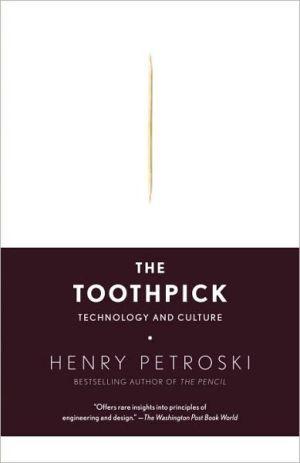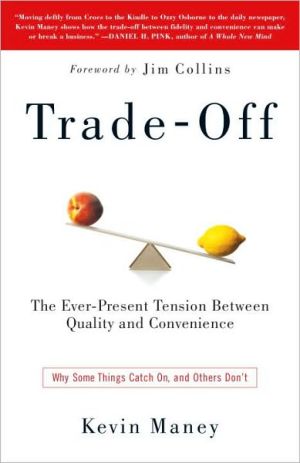The Toothpick: Technology and Culture
A celebration culture and technology, as seen through the history of the humble yet ubiquitous toothpick, from the best-selling author of The Pencil.\ From ancient Rome, where emperor Nero made his entrance into a banquet hall with a silver toothpick in his mouth, to nineteenth-century Boston, where Charles Forster, the father of the American wooden toothpick industry, ensured toothpicks appeared in every restaurant, the toothpick has been an omnipresent, yet often overlooked part of our...
Search in google:
Like The Pencil, Henry Petroski’s The Toothpick is a celebration of a humble yet elegant device. As old as mankind and as universal as eating, this useful and ubiquitous tool finally gets its due in this wide-ranging and compulsively readable book. Here is the unexpected story of the simplest of implements—whether made of grass, gold, quill, or wood—a story of engineering and design, of culture and class, and a lesson in how to discover the extraordinary in the ordinary.Petroski takes us back to ancient Rome, where the emperor Nero makes his entrance into a banquet hall with a silver toothpick in his mouth; and to a more recent time in Spain, where a young señorita uses the delicately pointed instrument to protect her virtue from someone trying to steal a kiss. He introduces us to Charles Forster, a nineteenth-century Bostonian and father of the American toothpick industry, who hires Harvard students to demand toothpicks in area restaurants—thereby making their availability in eating establishments as expected as condiments. And Petroski takes us inside the surprisingly secretive toothpick-manufacturing industry, in which one small town’s factories can turn out 200 million wooden toothpicks a day using methods that, except for computer controls, haven’t changed much in almost 150 years. He also explores a treasure trove of the toothpick’s unintended uses and perils, from sandwiches to martinis and beyond.With an engineer’s eye for detail and a poet’s flair for language, Petroski has earned his reputation as a writer who explains our world—from the tallest buildings to the lowliest toothpick—to us. The Barnes & Noble Review How many pages can you fit on the point of a toothpick? Surprisingly enough, about 350 -- but only if you're the ingenious Henry Petroski, author of such entertaining and enlightening volumes as To Engineer Is Human: The Role of Failure in Successful Design and The Evolution of Useful Things. This book employs the same deft and delightful attention to a simple object that he used with such success in The Pencil: A History of Design and Circumstance. Here, he whittles down his focus to a smaller and even humbler wooden implement, one that is "among the simplest of manufactured things." Its story, however -- in Petroski's learned and witty hands, at least -- is anything but simple. The author entertainingly traces the use, design, materials, manufacture, and cultural connotations of the handy utensil from the Rome of Nero to 16th-century Portugal (where industrious nuns created a local cottage industry), from 19th-century Cambridge, Massachusetts (where toothpick tycoon Charles Forster put Harvard men to work creating demand) to more recent years (when, in keeping with the industry's enduring penchant for secrecy, Japanese visitors were denied entry to a Maine toothpick factory in order to protect "tricks of the trade"). "Because common things so easily transcend limits of time and place, their story is not readily confined to a single period or to a single culture," Petroski writes. Crossing chronological, disciplinary, and geographical boundaries, Petroski's engaging tale moves from anthropology to etiquette, from prehistoric Africa to the 1900 American presidential election, with remarkable aplomb. --James Mustich
The Toothpick\ Technology and Culture \ \ By Henry Petroski \ Knopf\ Copyright © 2007 Henry Petroski\ All right reserved.\ ISBN: 9780307266361 \ \ \ Prologue\ \ The plain wooden toothpick, it may be argued, is among the simplest of manufactured things. It consists of a single part, made of a single material, intended for a single purpose–from which it gets its simple name. It is also among the most convenient and ready of things. It can be used directly out of the box–there being no instructions to read, no parts to assemble, no priming or booting required, and no maintenance expected. When it has served its purpose, it is simply discarded.\ \ Such simplicity of design and use might lead one to expect an equally simple and straightforward history, one easily researched and explicated by a student doing a term paper. In the twenty-first century, such a student would very likely navigate around the World Wide Web via Google or some other digital search engine and come up with enough snippets to stitch together a plausible story–as long as the sources were unquestioned, the gaps glossed over, and the contradictions ignored. Of the quotations rustled up from the Web and corralled at the beginning of this book, every one but the statement about generating power from wood waste is at best a half-truth.\ \ In fact, the full and true story of something even so simple as the toothpickcannot easily be gleaned from the Internet alone. Unfortunately, more traditional sources of information and scholarship, such as manuscripts, articles, books, and other written materials in archives and analog libraries, also often provide sparse, erroneous, and contradictory information for topics considered too banal for and thus neglected by scholars seeking to pursue grander things and themes.\ \ The very simplicity and banality of the thing made the toothpick and its manufacture an artifact of tacit knowledge and trade secrets. Even in the late twentieth century, Japanese visitors who showed up at a Maine toothpick factory were turned away, lest they see the tricks of the trade. An American scholar, who should hardly have been seen as a potential competitor, was similarly denied entrance to a Minnesota counterpart. He had to go to Sweden to see some toothpicks being made.\ \ Secrecy coupled with a dearth of reliable, confirmable documentary material makes the task of uncovering the real story of a common object a challenge for ordinary scholarship relying on the usual scholarly sources. But there are other sources of information, not least of which is the artifact itself and the documented social and cultural context in which it has been made and used. Much of the story of the toothpick must be coaxed out of the thing itself and its milieu. With patience, slivers of it can be teased out of even a closed box of toothpicks the way a stubborn seed eventually can be dislodged from between the teeth. Insights into the use and misuse of things can be gleaned from both the froth and the detritus of society.\ \ Whatever its history, the toothpick-manufacturing process has become so automated and efficient that no human hand touches the product until it is taken up to be used. An antiseptic toothpick costs but a fraction of a fraction of a cent, and it can be tossed away after a single use. Since it is made of untreated wood, the biodegradable toothpick presents no substantial danger to the environment. At first glance, it seems not easily implicated in global warming–until we remember that trees have been sacrificed for and energy consumed in its production.\ \ But as neglected, small, insignificant, and inconsequential as the artifact might seem to be, the story of the toothpick holds great potential for revealing often hidden and frequently overlooked relationships among the people and things of the world. As Archimedes asserted that, if he were given a long enough lever and a place on which to stand, he could move the earth, so we can imagine that, given a toothpick and a sense of its place in history, we can nudge our understanding of technology and culture a bit farther.\ \ Since the toothpick is a technological and cultural artifact, its use and significance are determined by its producers and consumers as they have over time been embedded in the life of business and the business of life. Individuals can develop a dependency on toothpicks, a preference for certain shapes and sizes, and a set of habits and rituals surrounding their use. Society, ever subject to the fads and fashions that it itself creates, imposes changing expectations on the availability of toothpicks and on the manner and acceptability of their use. Different classes of people, being attuned to different social rhythms and cultural clocks, develop different relationships with toothpicks. This is naturally part of the story.\ \ Because common things so easily transcend limits of time and place, their story is not readily confined to a single period or to a single culture. The history of the toothpick is as old as mankind and as universal as eating. Its story knows no disciplinary bounds, and it is revealed in the records of anthropology as surely as in the annals of etiquette. It is an international story, with chapters set in prehistoric Africa, ancient Greece and Rome, medieval Portugal, and modern Brazil, China, Japan, Sweden, and the United States, to name but a few of its backdrops. The story of the toothpick is the story of Everyone and Everything at Everytime.\ \ Things get their names and reputations from people, and it is people who also dictate how things are spoken of and used. As much as its name defines a single intended purpose, the toothpick has been adapted to countless other uses. Like any tool or device, the toothpick has been called into service when something else was not available or suitable to the task at hand. This, too, is part of the story of the thing, as is its propensity to spawn an infrastructure of boxes, cases, dispensers, holders, and other contraptions that can be as extraordinarily diverse and complex as the one-part machine that they support is simple.\ \ To an engineer, the challenge of mass-producing something like a toothpick with sufficient efficiency that it can be sold at a profit holds a special fascination. The origins and rise of the mechanized toothpick industry in the latter half of the nineteenth century make for a fascinating chapter in the history of manufacturing, as do the human stories of inventors and innovators such as Benjamin Franklin Sturtevant and Charles Forster, along with their inventions, their patents and patent rights, and their struggles through failures on their way to achieving successes. It is in this chapter of the story that the history of the modest toothpick assumes heroic proportions and provides especially poignant lessons for the technological enterprises of today and tomorrow.\ \ \ \ Chapter One: The Oldest Habit\ \ Nothing can be more annoying than having a piece of food stuck between our teeth. As tiny as it might really be, in time it can seem to grow out of all proportion to its place in the mouth. As the pea under the princess’s mattress prevented her from enjoying a night’s sleep, so a tiny seed between molars can deny the diner much-anticipated postprandial peace and satisfaction. Like a grain of sand between two millstones, the foreign matter grates on us until it is worked free.\ \ We have all devised our own preferred methods for dealing with the problem, but when we are not alone some of us may be constrained by social strictures to work within a closed mouth. Our tongue is often the instrument of choice, but the tongue’s soft, blunt tip is usually ineffective. We have to flex and strain the muscles that harden and point it, and the process can be excruciatingly trying, tiring, and not really so private or inconspicuous as we might wish.\ \ When wooden matches were commonly found near the kitchen stove, they were convenient to be split or whittled into toothpicks. One uninhibited character in a 1920s novel entered a shop “still helping the breadcrust out of his teeth . . . with his tongue,” supplemented by a split matchstick, which was a sure giveaway of his plight.[1] However, even without opening our mouth to use a pointed tool, whenever we proceed to drag the tongue across and thrust it between our teeth at a repast’s tenacious residue, we reveal our mission by the bulge moving around our lips and cheeks like a mole beneath the lawn.\ \ Sucking at the stuck debris can sometimes be effective, but not always easily for stubborn little things. It takes more than eight pages in James Joyce’s A Portrait of the Artist as a Young Man, involving “sucking at a crevice in his teeth,” among other efforts, for the character Cranly to dislodge fig seeds.[2] We can also try squirting saliva between the teeth to flush out some unfriendly food debris. However, like vacuuming a rug or washing windows with a water hose, such actions can be noisy. The overzealous tooth sucker whose lips slip apart can sound like a wet kisser bussing the air, the too-eager spit squisher like someone squeezing a wet sponge.\ \ The finger can be an effective lever to move what will not otherwise budge, but in many circles its use points to the defeat of other means. Besides, like the tongue, the finger is usually too blunt an instrument for the task at hand, and some people have been known to “grow a long finger nail especially for picking teeth.”[3] Sometimes, even an ordinary fingernail can be enlisted successfully, but implementing it as a solution can seldom be done with grace.\ \ The most common alternative to natural and self-contained means is, of course, the familiar wooden toothpick. Where social strictures do not censure its use, the toothpick can be a most effective tool to succeed where tongue and fingers fail. As all tools are extensions of our bodies and their extremities, so the toothpick is an extension of the finger. It allows us to reach into the back of our mouth more easily and effectively, a need that has existed coevally with the need for food itself. Indeed, it has been suggested that “the ability to sense and remove food particles between teeth” dates from a couple million years ago, and that toothpicking represents “the earliest currently known nonlithic tool use by hominids.”[4] Hence, picking one’s teeth is believed to be the oldest human habit.[5]\ \ The evidence comes from fossilized teeth, which have been called “the most durable relics of early life,” certainly outlasting any toothpicks that may have been used on them.[6] Unlike stone tools, implements made of grass, thorn, wood, or other vegetable materials would decay or erode over time, leaving no artifacts recognizable as toothpicks. However, for nearly a century, anthropologists around the world have noted curious striated grooves on fossilized teeth from a large number of diverse locations and covering a great span of time. As early as 1911, a French anthropologist described grooved teeth found at the La Quina Neanderthal site and proposed the hypothesis that it was the use of abrasive toothpicks that caused the grooves.[7] Subsequently, similarly grooved teeth have been found among the remains of Australian Aborigines, North American Indians, Canary Islanders, and Upper Dynastic Egyptians, as well as other populations.[8] The oldest examples of such grooving have been found in Africa. A tooth from the Olduvai Gorge archeological site in Tanzania “bears a series of tiny parallel lines scraped by a sharp, thin object pushed into the narrow space between teeth.”[9] An example from the Ethiopian site Omo has been estimated to be almost two million years old.[10]\ \ It has been speculated that the use of toothpicks may have commenced with meat eating among early hominids, and that “the intent of primitive man was by no means the artificial cleaning of his teeth but simply the removal of an unpleasant subjective sensation.”[11] Even today, after ages of evolution, our teeth are still “not well designed for eating meat,” as those of us who are not vegetarians know all too well.[12] It is stringy pieces of meat that can be the most difficult to remove from their lodging place. Still, that the grooves in fossilized teeth were due to toothpick use has been debated among anthropologists, some of whom did not believe that simply picking food particles from between the teeth, even over a lifetime of eating, could cause such distinct grooves, some of which are as much as two millimeters wide.[13]\ \ To produce such damage, it has been believed, there would have to be the prolonged working back and forth of a toothpick or toothpick-like device. One theory was that toothpicks were used not simply to remove bits of food but to serve the therapeutic and palliative function of easing the pain of periodontal disease and dental caries. Extended use might have worn away the decay and left a clean groove. Regular toothpick use may have caused the triangular opening bounded by neighboring teeth and gums to grow, thereby allowing more food to become impacted in the space, thus requiring further probing. Sensitive gums might have encouraged prolonged toothpick use, which might also have resulted in grooving.[14] It has even been proposed that the practice “may have been a largely unnecessary, non-functional pastime that was cultural rather than practical.”[15] Whatever its cause or motivation, the grooving of teeth appears to have been ubiquitous.[16]\ \ \ \ NOTES\ [1] Hugh de Selincourt, The Cricket Match (Oxford: Oxford University Press, 1924), quoted in M. E. Richardson, “In Sickness and in Health,” British Dental Journal, no. 9 (2004), 583.\ [2] James Joyce, A Portrait of the Artist as a Young Man (New York: Viking Press, 1956), 215, 229-35, 247.\ [3] Mary Joe Clendenin, “People and Toothpicks Make History,” http://www.our-town.com/editorials/Edge-Clendenin/edgepicks.htm (Apr. 5, 2006).\ [4] William A. Agger, Timothy L. McAndrews. and John A. Hlaudy, “On Toothpicking in Early Hominids,” Current Anthropology 45, no. 3 (2004), 403-4.\ [5] See, e.g. Christy G. Turner II, “Interproximal Grooving of Teeth: Additional Evidence and Interpretation,” Current Anthropology 29, no. 4 (1988), 664-65.\ [6] John Noble Wilford, “But Did They Floss?” New York Times, Mar. 7, 1989, C1.\ [7] A Siffre, “Notre sur une usure spéciale des molaires du squelette de la Quina,” Bulletin de la Societé Préhistorique Française 8 (1911), 741-43.\ [8] See Christy G. Turner II and Eric Cacciatore, “Interproximal Tooth Grooves in Pacific Basin, East Asian, and New World Populations,” Anthropological Science 106, supp. (1988), 85-94; Douglas H. Ubelaker, T. W. Phenice, and William M. Bass, “Artificial Interproximal Grooving of the Teeth in American Indians,” American Journal of Physical Anthropology 30 (1969), 145-50; K. M. Reese, “Toothpicks May Have Been Among Humans’ Early Tools,” Chemical and Engineering News, Mar. 27, 1989, 48.\ [9] “First Pick,” New Scientist, Apr. 22, 2000, 19.\ [10] See, e.g., Paul G. Bahn, “Early Teething Troubles,” Nature 337 (Feb. 23, 1989), 693.\ [11] “Ancient Toothpicks Point to Evidence of Early Meat-Eating Hominids,” Journal of Dental Technology 17, no. 5 (2000), 27; Irwin D. Mandel, “Why Pick on Teeth?” Journal of the American Dental Association 121 (Jul. 1990), 129.\ [12] Peter Ungar, quoted in “Ancient Toothpicks,” 27.\ [13] Ubelaker, Phenice, and Bass, “Artificial Interproximal Grooving,” 145.\ [14] Ibid., 147. See also Vincenzo Fromincola, “Interproximal Grooving of Teeth: Additional Evidence and Interpretation,” Current Anthropology 29, no. 4 (Aug.—Oct. 1988), 663-64.\ [15] See Bahn, “Early Teething Troubles.”\ [16] Robert B. Eckhardt and Andrea L. Piermarini, “Interproximal Grooving of Teeth: Additional Evidence and Interpretation,” Current Anthropology 29, no. 4 (Aug.—Oct. 1988), 668. \ \ Continues... \ \ \ \ Excerpted from The Toothpick by Henry Petroski Copyright © 2007 by Henry Petroski. Excerpted by permission.\ All rights reserved. No part of this excerpt may be reproduced or reprinted without permission in writing from the publisher.\ Excerpts are provided by Dial-A-Book Inc. solely for the personal use of visitors to this web site. \ \
Preface xiPrologue 3The Oldest Habit 6Artifacts and Texts 12Sucksacks and Whiskers 20Poor Goose! 25Out of the Woods 36Made in Portugal 42Charles Forster in Pernambuco 48From Pegs to Riches 59A Family Affair 74Going Where the Wood Is 84An Article for the Million 96Advice and Dissent 112The Nasty Instrument 124The Toothpick Man 140Cords of Paper Birch 160Trade Secrets and Closed Doors 173Other Toothpicks 192New Uses for Old 202Maurice, Oscar, and the Industry 211The Tragic Heiress 223Exeunt Oscar and Maurice 231Foreign Affairs 241Old Gold and Good Wood 257Boxed and Unboxed 267Woodpeckers and Other Dispensers 279Talking Round a Toothpick 290The Fatal Martini 308Improving on Perfection 320The Butler Did It 330Epilogue 347Notes 355Acknowledgments 415Illustrations and Credits 421Index 425
\ Joshua GlennA satirist once described a fictitious journal, titled "History's Splendid Splinter," which was devoted to scholarly essays on the wooden toothpick's "role in social history, patterns of forestry, and the evolving technology of toothpick manufacture." Henry Petroski, who quotes this dig at minutiae-obsessed pedants, gets the joke but refutes it, insisting that even the most insignificant objects can reward our close attention with new revelations. In fact, he spent years researching toothpick manufacture in small-town New England libraries and combing digital archives and dusty patent files and even assiduously picking his own teeth. The end result is a book that offers rare insights into principles of engineering and design, as well as the oddly inspiring story of one man's quixotic mission to put a toothpick in every American's mouth.\ —The Washington Post\ \ \ \ \ Publishers WeeklyThe toothpick is not just "among the simplest of manufactured things," Petroski explains, but one of the oldest: Grooves on fossilized teeth suggest that early hominids might have regularly applied small sticks or even blades of grass to the spaces between their teeth. With his usual flair for combining technical expertise and cultural acumen, Petroski (The Pencil) presents nearly every toothpick in the historical record. No incident seems too small to escape his notice, from the Qur'an's endorsement of using toothpicks before praying to Sherwood Anderson's death by a still-skewered martini olive. The narrative eventually closes in on Charles Forster, the entrepreneur who introduced the mass manufacture of toothpicks to Maine and created an American industry; the battle over the Forster estate led to a mildly melodramatic family squabble. Petroski occasionally offers a first-person perspective, describing the unpleasant feel of a bamboo pick or confessing that sometimes he'll resort to a mechanical pencil. Although some readers may feel he pushes the limits of the "history of ordinary objects" genre, there's still enough intriguing detail, even in the minute evolutions of toothpick etiquette, to keep readers engaged. Photos and illus. throughout. (Oct. 17)\ Copyright 2007 Reed Business Information\ \ \ Library JournalPetroski (civil engineering & history, Duke Univ.; Pushing the Limits: New Adventures in Engineering), a prolific writer on design, engineering, and "useful things" in our culture, has found yet another story needing to be told, the late history of the toothpick. Who knew it involved colorful characters, intellectual property battles, shady marketing practices, trade secrets, and manufacturing productivity expectations 100 years before the product's time? While the toothpick has been around since the dawn of humankind in all areas of the globe, Petroski focuses on its late (19th- and 20th-century) history in the United States. He playfully teases out the story from a wealth of archival sources, using a mix of biography, business, and industrial history in exploring the toothpick both in terms of its manufacture and its usage in society. As a tale of innovation, this profile demonstrates that the more things change, the more they stay the same. A fascinating read recommended for academic and public libraries to satisfy history of technology fans or folks simply wanting to understand and appreciate better the world around them. [See Prepub Alert, LJ6/1/07.]\ —James A. Buczynski\ \ \ \ \ \ Kirkus ReviewsA comprehensive report on the ubiquitous wooden sliver's past, present and future, from the seasoned historian of life's indispensables. Though Petroski (Success Through Failure, 2006, etc.) admits to not being a regular toothpick user, his interest for this "simplest of manufactured things" is as limitless as the research material he pored over. In early 1911, grooves found on fossilized teeth suggested the existence of primitive teeth-cleaning utensils, perhaps made from such materials as grass, straw, animal claws, bird quills, rat skeletons, walrus whiskers and raccoon penis bones. The author examines his subject's highly speculative genesis from an ornate item handmade in Portugal to the mass-produced, machine-made product introduced to America by philanthropic Massachusetts import-export businessman Charles Forster. Petroski also profiles industrious machinist Benjamin Sturtevant, who single-handedly developed the toothpick machine, dubbing it a "minor invention" as compared with the shoe-pegging and exhaust fanning devices he'd built during the same era. Forster saw promise in Sturtevant's technological genius and brought his toothpick apparatus to Maine (where white birch wood is plentiful), creating a manufacturing, marketing and retailing craze in the late 1880s. Petroski touches on the toothpick's varying degrees of social acceptance in a consistently interesting section. While it was "worn and used most conspicuously and proudly" during the Renaissance, a pick precariously positioned out of one's mouth by the 20th century was considered vulgar-or democratically down-to-earth, depending on your point of view. The author taste tests a variety of foreign and domestic picks andgraciously offers colorful personal opinions on his varied discoveries. Generous illustrations add texture to the sometimes dry, almost textbook-worthy narrative flow as Petroski examines the toothpick's boundless uses, from freeing stubborn debris and serving hors d'oeuvres to testing baked goods for doneness or skewering unsympathetic cellmates. An educational and savory meal, overdone but still flavorful.\ \ \ \ \ The Barnes & Noble ReviewHow many pages can you fit on the point of a toothpick? Surprisingly enough, about 350 -- but only if you're the ingenious Henry Petroski, author of such entertaining and enlightening volumes as To Engineer Is Human: The Role of Failure in Successful Design and The Evolution of Useful Things. This book employs the same deft and delightful attention to a simple object that he used with such success in The Pencil: A History of Design and Circumstance. Here, he whittles down his focus to a smaller and even humbler wooden implement, one that is "among the simplest of manufactured things." Its story, however -- in Petroski's learned and witty hands, at least -- is anything but simple. The author entertainingly traces the use, design, materials, manufacture, and cultural connotations of the handy utensil from the Rome of Nero to 16th-century Portugal (where industrious nuns created a local cottage industry), from 19th-century Cambridge, Massachusetts (where toothpick tycoon Charles Forster put Harvard men to work creating demand) to more recent years (when, in keeping with the industry's enduring penchant for secrecy, Japanese visitors were denied entry to a Maine toothpick factory in order to protect "tricks of the trade"). "Because common things so easily transcend limits of time and place, their story is not readily confined to a single period or to a single culture," Petroski writes. Crossing chronological, disciplinary, and geographical boundaries, Petroski's engaging tale moves from anthropology to etiquette, from prehistoric Africa to the 1900 American presidential election, with remarkable aplomb. \ --James Mustich\ \








